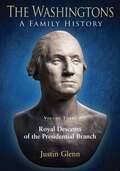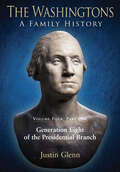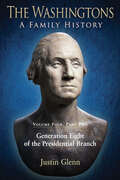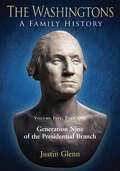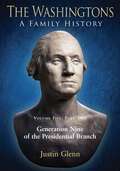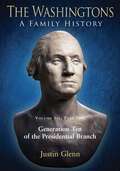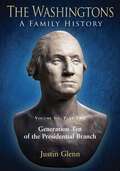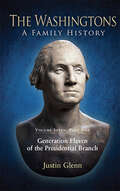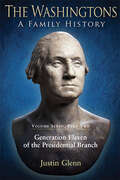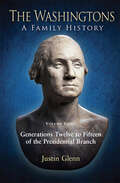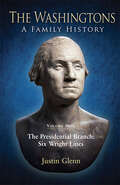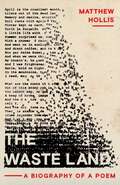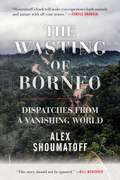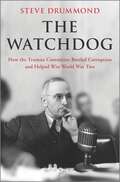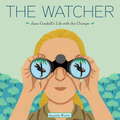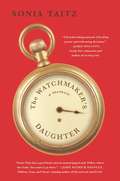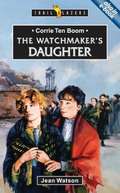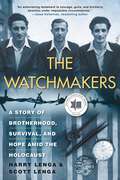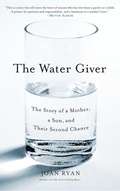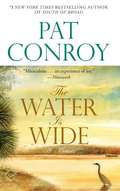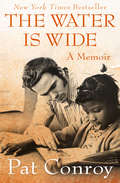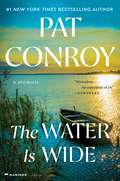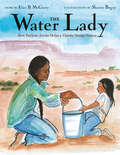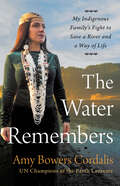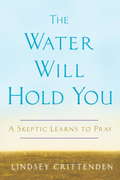- Table View
- List View
The Washingtons. Volume 3: Royal Descents of the Presidential Branch (The Washingtons: A Family History #3)
by Justin GlennThis Royal Descents supplement is an outgrowth of the author’s multi-volume family history of the “Presidential Branch” of the Washingtons. That work collects the descendants of the immigrant John Washington who settled in Westmoreland Co., Va., in 1657, married Anne Pope, and became the great-grandfather of President George Washington. The Royal Descents traces the ancestry of the early Virginia members of this “Presidential Branch” back in time to the aristocracy and nobility of England and continental Europe, including the Plantagenet dynasty, William the Conqueror, Alfred the Great, Charles Martel, and Charlemagne. ADVANCE PRAISE for The Washingtons: A Family History “I am convinced that your work will be of wide interest to historians and academics as well as members of the Washington family itself. Although the surname Washington is perhaps the best known in American history and much has been written about the Washington family for well over a century, it is surprising that no comprehensive family history has been published. Justin M. Glenn’s The Washingtons: A Family History finally fills this void for the branch to which General and President George Washington belonged, identifying some 63,000 descendants. This is truly a family history, not a mere tabulation of names and dates, providing biographical accounts of many of the descendants of John Washington who settled in Westmoreland County, Virginia, in 1657. . . . Each individual section is followed by extensive listings of published and manuscript sources supporting the information presented and errors of identification in previous publications are commented upon as appropriate.” John Frederick Dorman, editor of The Virginia Genealogist (1957-2006) and author of Adventurers of Purse and Person “Decades of reviewing Civil War books have left me surprised and delighted when someone applies exhaustive diligence to a topic not readily accessible. Dr. Glenn surely meets that standard with the meticulous research that unveils the Washington family in gratifying detail—many of them Confederates of interest and importance.” Robert K. Krick, author of The Smoothbore Volley that Doomed the Confederacy and Stonewall Jackson at Cedar Mountain
The Washingtons. Volume 4, Part 1: Generation Eight of the Presidential Branch (The Washingtons: A Family History #4.2)
by Justin GlennThis is the fourth volume of Dr. Justin Glenn’s comprehensive history that traces the “Presidential line” of the Washingtons. Volume One began with the immigrant John Washington, who settled in Westmoreland Co., Va., in 1657, married Anne Pope, and became the great-grandfather of President George Washington. It continued the record of their descendants for a total of seven generations. Volume Two highlighted notable members of the next eight generations of John and Anne Washington’s descendants, including General George S. Patton, author Shelby Foote, and actor Lee Marvin. Volume Three traced the ancestry of the early Virginia members of this “Presidential Branch” back in time to the aristocracy and nobility of England and continental Europe. Volume Four resumes the family history where Volume One ended. It presents Generation Eight of the immigrant John Washington’s descendants, containing nearly 7,000 descendants. Future volumes will trace generations nine through fifteen, making a total of over 63,000 descendants. Although structured in a genealogical format for the sake of clarity, this is no bare bones genealogy but a true family history with over 1,200 detailed biographical narratives. These in turn strive to convey the greatness of the family that produced not only The Father of His Country but many others, great and humble, who struggled to build that country. Volume Four, Part One covers the descendants of the immigrant John Washington’s child Lawrence Washington. Volume Four, Part Two covers the descendants of the Immigrant’s children John Washington, Jr., and Anne (Washington) Wright.
The Washingtons. Volume 4, Part 2: Generation Eight of the Presidential Branch (The Washingtons: A Family History #4.2)
by Justin GlennThis is the fourth volume of Dr. Justin Glenn’s comprehensive history that traces the “Presidential line” of the Washingtons. Volume One began with the immigrant John Washington, who settled in Westmoreland Co., Va., in 1657, married Anne Pope, and became the great-grandfather of President George Washington. It continued the record of their descendants for a total of seven generations. Volume Two highlighted notable members of the next eight generations of John and Anne Washington’s descendants, including General George S. Patton, author Shelby Foote, and actor Lee Marvin. Volume Three traced the ancestry of the early Virginia members of this “Presidential Branch” back in time to the aristocracy and nobility of England and continental Europe. Volume Four resumes the family history where Volume One ended. It presents Generation Eight of the immigrant John Washington’s descendants, containing nearly 7,000 descendants. Future volumes will trace generations nine through fifteen, making a total of over 63,000 descendants. Although structured in a genealogical format for the sake of clarity, this is no bare bones genealogy but a true family history with over 1,200 detailed biographical narratives. These in turn strive to convey the greatness of the family that produced not only The Father of His Country but many others, great and humble, who struggled to build that country. Volume Four, Part One covers the descendants of the immigrant John Washington’s child Lawrence Washington. Volume Four, Part Two covers the descendants of the Immigrant’s children John Washington, Jr., and Anne (Washington) Wright.
The Washingtons. Volume 5, Part 1: Generation Nine of the Presidential Branch (The Washingtons: A Family History #5.1)
by Justin GlennThis is the fifth volume of Dr. Justin Glenn’s comprehensive history that traces the “Presidential line” of the Washingtons. Volume One began with the immigrant John Washington, who settled in Westmoreland Co., Va., in 1657, married Anne Pope, and became the great-grandfather of President George Washington. It continued the record of their descendants for a total of seven generations. Volume Two highlighted notable family members in the next eight generations of John and Anne Washington’s descendants, including such luminaries as General George S. Patton, the author Shelby Foote, and the actor Lee Marvin. Volume Three traced the ancestry of the early Virginia members of this “Presidential Branch” back in time to the aristocracy and nobility of England and continental Europe. Volume Four resumed the family history where Volume One ended, and it contained Generation Eight of the immigrant John Washington’s descendants. Volume Five now presents Generation Nine, including more than 10,000 descendants. Future volumes will trace generations ten through fifteen, making a total of over 63,000 descendants. Although structured in a genealogical format for the sake of clarity, this is no bare bones genealogy but a true family history with over 1,200 detailed biographical narratives. These in turn strive to convey the greatness of the family that produced not only The Father of His Country but many others, great and humble, who struggled to build that country. ADVANCE PRAISE “I am convinced that your work will be of wide interest to historians and academics as well as members of the Washington family itself. Although the surname Washington is perhaps the best known in American history and much has been written about the Washington family for well over a century, it is surprising that no comprehensive family history has been published. Justin M. Glenn’s The Washingtons: A Family History finally fills this void for the branch to which General and President George Washington belonged, identifying some 63,000 descendants. This is truly a family history, not a mere tabulation of names and dates, providing biographical accounts of many of the descendants of John Washington who settled in Westmoreland County, Virginia, in 1657. . . . Each individual section is followed by extensive listings of published and manuscript sources supporting the information presented and errors of identification in previous publications are commented upon as appropriate.” John Frederick Dorman, editor of The Virginia Genealogist (1957-2006) and author of Adventurers of Purse and Person “Decades of reviewing Civil War books have left me surprised and delighted when someone applies exhaustive diligence to a topic not readily accessible. Dr. Glenn surely meets that standard with the meticulous research that unveils the Washington family in gratifying detail—many of them Confederates of interest and importance.” Robert K. Krick, author of The Smoothbore Volley that Doomed the Confederacy and Stonewall Jackson at Cedar Mountain
The Washingtons. Volume 5, Part 2: Generation Nine of the Presidential Branch (The Washingtons: A Family History #5.1)
by Justin GlennThis is the fifth volume of Dr. Justin Glenn’s comprehensive history that traces the “Presidential line” of the Washingtons. Volume One began with the immigrant John Washington, who settled in Westmoreland Co., Va., in 1657, married Anne Pope, and became the great-grandfather of President George Washington. It continued the record of their descendants for a total of seven generations. Volume Two highlighted notable family members in the next eight generations of John and Anne Washington’s descendants, including such luminaries as General George S. Patton, the author Shelby Foote, and the actor Lee Marvin. Volume Three traced the ancestry of the early Virginia members of this “Presidential Branch” back in time to the aristocracy and nobility of England and continental Europe. Volume Four resumed the family history where Volume One ended, and it contained Generation Eight of the immigrant John Washington’s descendants. Volume Five now presents Generation Nine, including more than 10,000 descendants. Future volumes will trace generations ten through fifteen, making a total of over 63,000 descendants. Although structured in a genealogical format for the sake of clarity, this is no bare bones genealogy but a true family history with over 1,200 detailed biographical narratives. These in turn strive to convey the greatness of the family that produced not only The Father of His Country but many others, great and humble, who struggled to build that country. ADVANCE PRAISE “I am convinced that your work will be of wide interest to historians and academics as well as members of the Washington family itself. Although the surname Washington is perhaps the best known in American history and much has been written about the Washington family for well over a century, it is surprising that no comprehensive family history has been published. Justin M. Glenn’s The Washingtons: A Family History finally fills this void for the branch to which General and President George Washington belonged, identifying some 63,000 descendants. This is truly a family history, not a mere tabulation of names and dates, providing biographical accounts of many of the descendants of John Washington who settled in Westmoreland County, Virginia, in 1657. . . . Each individual section is followed by extensive listings of published and manuscript sources supporting the information presented and errors of identification in previous publications are commented upon as appropriate.” John Frederick Dorman, editor of The Virginia Genealogist (1957-2006) and author of Adventurers of Purse and Person “Decades of reviewing Civil War books have left me surprised and delighted when someone applies exhaustive diligence to a topic not readily accessible. Dr. Glenn surely meets that standard with the meticulous research that unveils the Washington family in gratifying detail—many of them Confederates of interest and importance.” Robert K. Krick, author of The Smoothbore Volley that Doomed the Confederacy and Stonewall Jackson at Cedar Mountain
The Washingtons. Volume 6, Part 1: Generation Ten of the Presidential Branch (The Washingtons: A Family History #6.1)
by Justin GlennThis is the sixth volume of Dr. Justin Glenn’s comprehensive history that traces the “Presidential line” of the Washingtons. Volume One began with the immigrant John Washington, who settled in Westmoreland Co., Va., in 1657, married Anne Pope, and became the great-grandfather of President George Washington. It continued the record of their descendants for a total of seven generations. Volume Two highlighted notable family members in the next eight generations of John and Anne Washington’s descendants. Volume Three traced the ancestry of the early Virginia members of this “Presidential Branch” back to the aristocracy and nobility of England and continental Europe. Volume Four resumed the family history where Volume One ended, and it contained Generation Eight of the immigrant John Washington’s descendants. Volume Five treated Generation Nine. Volume Six now presents Generation Ten, and it includes over 12,000 descendants. Future volumes will add generations eleven through fifteen, making a total of over 63,000 descendants. Although structured in a genealogical format for the sake of clarity, this is no bare bones genealogy but a true family history with over 1,200 detailed biographical narratives. These in turn strive to convey the greatness of the family that produced not only The Father of His Country but many others, great and humble, who struggled to build that country. Volume Six, Part One covers the descendants of the Immigrant John Washington’s children Lawrence Washington and John Washington, Jr. Volume Six, Part Two covers the descendants of the Immigrant’s child Anne (Washington) Wright.
The Washingtons. Volume 6, Part 2: Generation Ten of the Presidential Branch (The Washingtons: A Family History #6.1)
by Justin GlennThis is the sixth volume of Dr. Justin Glenn’s comprehensive history that traces the “Presidential line” of the Washingtons. Volume One began with the immigrant John Washington, who settled in Westmoreland Co., Va., in 1657, married Anne Pope, and became the great-grandfather of President George Washington. It continued the record of their descendants for a total of seven generations. Volume Two highlighted notable family members in the next eight generations of John and Anne Washington’s descendants. Volume Three traced the ancestry of the early Virginia members of this “Presidential Branch” back in time to the aristocracy and nobility of England and continental Europe. Volume Four resumed the family history where Volume One ended, and it contained Generation Eight of the immigrant John Washington’s descendants. Volume Five treated Generation Nine. Volume Six now presents Generation Ten, and it includes over 12,000 descendants. Future volumes will add generations eleven through fifteen, making a total of over 63,000 descendants. Although structured in a genealogical format for the sake of clarity, this is no bare bones genealogy but a true family history with over 1,200 detailed biographical narratives. These in turn strive to convey the greatness of the family that produced not only The Father of His Country but many others, great and humble, who struggled to build that country. ADVANCE PRAISE “I am convinced that your work will be of wide interest to historians and academics as well as members of the Washington family itself. Although the surname Washington is perhaps the best known in American history and much has been written about the Washington family for well over a century, it is surprising that no comprehensive family history has been published. Justin M. Glenn’s The Washingtons: A Family History finally fills this void for the branch to which General and President George Washington belonged, identifying some 63,000 descendants. This is truly a family history, not a mere tabulation of names and dates, providing biographical accounts of many of the descendants of John Washington who settled in Westmoreland County, Virginia, in 1657. . . . Each individual section is followed by extensive listings of published and manuscript sources supporting the information presented and errors of identification in previous publications are commented upon as appropriate.” John Frederick Dorman, editor of The Virginia Genealogist (1957-2006) and author of Adventurers of Purse and Person “Decades of reviewing Civil War books have left me surprised and delighted when someone applies exhaustive diligence to a topic not readily accessible. Dr. Glenn surely meets that standard with the meticulous research that unveils the Washington family in gratifying detail—many of them Confederates of interest and importance.” Robert K. Krick, author of The Smoothbore Volley that Doomed the Confederacy and Stonewall Jackson at Cedar Mountain
The Washingtons. Volume 7, Part 1: Generation Eleven of the Presidential Branch (The Washingtons: A Family History #7.1)
by Justin GlennThis is the seventh volume of Dr. Justin Glenn’s comprehensive history that traces the “Presidential line” of the Washingtons. Volume one began with the immigrant John Washington, who settled in Westmoreland Co., Va., in 1657, married Anne Pope, and became the great-grandfather of President George Washington. It continued the record of their descendants for a total of seven generations. Volume two highlighted notable members of the next eight generations, including such luminaries as General George S. Patton, the author Shelby Foote, and the actor Lee Marvin. Volume three traced the ancestry of the early Virginia members of this “Presidential Branch” back to the royalty and nobility of England and continental Europe. Volumes four, five, and six treated respectively generations eight, nine, and ten. Volume Seven presents generation eleven, comprising more than 10,000 descendants of the immigrant John Washington. Although structured in a genealogical format for the sake of clarity, this is no bare bones genealogy but a true family history with over 1,200 detailed biographical narratives. These strive to convey the greatness of the family that produced not only The Father of His Country but many others, great and humble, who struggled to build that country. Volume Seven, Part One covers the descendants of the immigrant’s children Lawrence and John Washington, Jr. Volume Seven, Part Two covers the descendants of the immigrant’s child Anne (Washington) Wright.
The Washingtons. Volume 7, Part 2: Generation Eleven of the Presidential Branch (The Washingtons: A Family History #7.2)
by Justin GlennThis is the seventh volume of Dr. Justin Glenn’s comprehensive history that traces the “Presidential line” of the Washingtons. Volume one began with the immigrant John Washington, who settled in Westmoreland Co., Va., in 1657, married Anne Pope, and became the great-grandfather of President George Washington. It continued the record of their descendants for a total of seven generations. Volume two highlighted notable members of the next eight generations, including such luminaries as General George S. Patton, the author Shelby Foote, and the actor Lee Marvin. Volume three traced the ancestry of the early Virginia members of this “Presidential Branch” back to the royalty and nobility of England and continental Europe. Volumes four, five, and six treated respectively generations eight, nine, and ten. Volume Seven presents generation eleven, comprising more than 10,000 descendants of the immigrant John Washington. Although structured in a genealogical format for the sake of clarity, this is no bare bones genealogy but a true family history with over 1,200 detailed biographical narratives. These strive to convey the greatness of the family that produced not only The Father of His Country but many others, great and humble, who struggled to build that country. Volume Seven, Part One covers the descendants of the immigrant’s children Lawrence and John Washington, Jr. Volume Seven, Part Two covers the descendants of the immigrant’s child Anne (Washington) Wright.
The Washingtons. Volume 8: Generations Twelve to Fifteen of the Presidential Branch (The Washingtons: A Family History)
by Justin GlennThis is the eighth volume of Dr. Justin Glenn’s comprehensive history that traces the “Presidential line” of the Washingtons. Volume one began with the immigrant John Washington, who settled in Westmoreland Co., Va., in 1657, married Anne Pope, and became the great-grandfather of President George Washington. It continued the record of their descendants for a total of seven generations. Volume two highlighted notable members of the next eight generations, including such luminaries as General George S. Patton, the author Shelby Foote, and the actor Lee Marvin. Volume three traced the ancestry of the early Virginia members of this “Presidential Branch” back to the royalty and nobility of England and continental Europe. Volumes four, five, six, and seven treated respectively generations eight, nine, ten, and eleven. Volume Eight presents generations twelve through fifteen, comprising more than 8,500 descendants of the immigrant John Washington. Although structured in a genealogical format for the sake of clarity, this is no bare bones genealogy but a true family history with over 1,200 detailed biographical narratives. These strive to convey the greatness of the family that produced not only The Father of His Country but many others, great and humble, who struggled to build that country.
The Washingtons. Volume 9: The Presidential Branch: Six Wright Lines (The Washingtons: A Family History #9)
by Justin GlennThis is the ninth volume of a comprehensive history that traces the “Presidential Line” of the Washingtons. Volume one began with the immigrant John Washington who settled in Westmoreland Co., Va., in 1657, married Anne Pope, and was the great-grandfather of President George Washington. It contained the record of their descendants for a total of seven generations. Subsequent volumes two through eight continued this family history for an additional eight generations, highlighting most notable members (volume two) and tracing lines of descent from the royalty and nobility of England and continental Europe (volume three). Volume nine collects over 8,500 descendants of the recently discovered line of William Wright (died in Franklin Co., Va., ca. 1809). It also provides briefer accounts of five other early Wright families of Virginia that have often been mentioned by researchers as close kinsmen of George Washington, including: William Wright (died in Fauquier Co., Va., ca. 1805), Frances Wright and her husband Nimrod Ashby, and William Wright (died in Greensville Co., Va., by 1827). A cumulative index will complete the series as volume ten.
The Waste Land: A Biography Of A Poem
by Matthew HollisA riveting account of the making of T. S. Eliot’s celebrated poem The Waste Land on its centenary. Renowned as one of the world’s greatest poems, The Waste Land has been said to describe the moral decay of a world after war and the search for meaning in a meaningless era. It has been labeled the most truthful poem of its time; it has been branded a masterful fake. A century after its publication in 1922, T. S. Eliot’s enigmatic masterpiece remains one of the most influential works ever written, and yet one of the most mysterious. In a remarkable feat of biography, Matthew Hollis reconstructs the intellectual creation of the poem and brings the material reality of its charged times vividly to life. Presenting a mosaic of historical fragments, diaries, dynamic literary criticism, and illuminating new research, he reveals the cultural and personal trauma that forged The Waste Land through the lives of its protagonists—of Ezra Pound, who edited it; of Vivien Eliot, who sustained it; and of T. S. Eliot himself, whose private torment is woven into the seams of the work. The result is an unforgettable story of lives passing in opposing directions and the astounding literary legacy they would leave behind.
The Wasting of Borneo: Dispatches from a Vanishing World
by Alex ShoumatoffAcclaimed naturalist Alex Shoumatoff issues a worldwide call to protect the drastically endangered rainforests of BorneoIn his eleventh book, but his first in almost two decades, seasoned travel writer Alex Shoumatoff takes readers on a journey from the woods of rural New York to the rain forests of the Amazon and Borneo, documenting both the abundance of life and the threats to these vanishing Edens in a wide-ranging narrative.Alex and his best friend, Davie, spent their formative years in the forest of Bedford, New York. As adults they grew apart, but bonded by the “imaginary jungle” of their childhood, Alex and Davie reunited fifty years later for a trip to a real jungle, in the heart of Borneo. During the intervening years, Alex had become an author and literary journalist, traveling the world to bring to light places, animals, and indigenous cultures in peril. The two reconnect and spend three weeks together on Borneo, one of the most imperiled ecosystems on earth. Insatiable demand for the palm oil ubiquitous in consumer goods is wiping out the world’s most ancient and species-rich rain forest, home to the orangutan and countless other life-forms, including the Penan people, with whom Alex and Davie camp. The Penan have been living in Borneo’s rain forest for millennia, but 90 percent of the lowland rain forest has already been logged and burned to make way for vast oil-palm plantations. Among the most endangered tribal people on earth, the Penan are fighting for their right to exist.Shoumatoff condenses a lifetime of learning about what binds humans to animals, nature, and each other, culminating in a celebration of the Penan and a call for Westerners to address the palm-oil crisis and protect the biodiversity that sustains us all.
The Watchdog: How the Truman Committee Battled Corruption and Helped Win World War Two
by Steve DrummondThe story of how a little-known junior senator fought wartime corruption and, in the process, set himself up to become vice president and ultimately President Harry Truman. Months before Pearl Harbor, Franklin D. Roosevelt knew that the United States was on the verge of entering another world war for which it was dangerously ill-prepared. The urgent times demanded a transformation of the economy, with the government bankrolling the unfathomably expensive task of enlisting millions of citizens while also producing the equipment necessary to successfully fight—all of which opened up opportunities for graft, fraud and corruption. In The Watchdog, Steve Drummond draws the reader into the fast-paced story of how Harry Truman, still a newcomer to Washington politics, cobbled together a bipartisan team of men and women that took on powerful corporate entities and the Pentagon, placing Truman in the national spotlight and paving his path to the White House. Drawing on the largely unexamined records of the Truman Committee as well as oral histories, personal letters, newspaper archives and interviews, Steve Drummond—an award-winning senior editor and executive producer at NPR—brings the colorful characters and intrigue of the committee&’s work to life. The Watchdog provides readers with a window to a time that was far from perfect but where it was possible to root out corruption and hold those responsible to account. It shows us what can be possible if politicians are governed by the principles of their office rather than self-interest.
The Watcher: Jane Goodall's Life with the Chimps
by Jeanette WinterAcclaimed picture book biographer Jeanette Winter has found her perfect subject: Jane Goodall, the great observer of chimpanzees. Follow Jane from her childhood in London watching a robin on her windowsill, to her years in the African forests of Gombe, Tanzania, invited by brilliant scientist Louis Leakey to observe chimps, to her worldwide crusade to save these primates who are now in danger of extinction, and their habitat. Young animal lovers and Winter's many fans will welcome this fascinating and moving portrait of an extraordinary person and the animals to whom she has dedicated her life.From the Hardcover edition.
The Watchmaker's Daughter
by Sonia TaitzThe Watchmaker's Daughter tells the story of a child of two refugees: a watchmaker who saved lives within Dachau prison, and his wife, a gifted concert pianist about to make her debut when the Nazis seized power. In this memoir, Sonia Taitz is born into a world in which the Holocaust is discussed constantly by her insular concentration camp-surviving parents. This legacy, combined with Sonia's passion and intelligence, leads the author to forge an adventurous life in which she seeks to heal both her parents and herself through travel, achievement, and a daring love affair. Ironically, it is her marriage to a non-Jew that brings her parents the peace and fulfillment they would never have imagined possible. Sonia manages to combine her own independence with a tender dutifulness, honoring her parents' legacy while forging a new family of her own.
The Watchmaker's Daughter: The story of Corrie Ten Boom
by Jean WatsonThe story of Corrie ten Boom has inspired millions of people all over the world. Jean Watson is a skilful author and presents Corrie's stirring life and challenging hope-filled message for young readers. The Watchmaker's Daughter traces the life of this outstanding Christian woman from her childhood in Haarlem, through her suffering in Nazi concentration camps, to her world-wide ministry to the handicapped and underprivileged. This exciting victorious book will allow you to meet this beloved woman and learn of God's wonderful provision and blessing through adversity.
The Watchmakers: A Powerful WW2 Story of Brotherhood, Survival, and Hope Amid the Holocaust
by Harry Lenga Scott LengaTold through interviews with his son, Jewish watchmaker Harry Lenga&’s extraordinary memoir of endurance, faith, and a unique skill that kept three brothers together—and alive—during the darkest times of World War II. Harry Lenga was born to a family of Chassidic Jews in Kozhnitz, Poland. The proud sons of a watchmaker, Harry and his two brothers, Mailekh and Moishe, studied their father&’s trade at a young age. Upon the German invasion of Poland, when the Lenga family was upended, Harry and his brothers never anticipated that the tools acquired from their father would be the key to their survival. Under the most devastating conditions imaginable—with death always imminent—fixing watches for the Germans in the ghettos and brutal slave labor camps of occupied Poland and Austria bought their lives over and over again. From Wolanow and Starachowice to Auschwitz and Ebensee, Harry, Mailekh, and Moishe endured, bartered, worked, prayed, and lived to see liberation. Derived from more than a decade of interviews with Harry Lenga, conducted by his own son Scott and others, The Watchmakers is Harry&’s heartening and unflinchingly honest first-person account of his childhood, the lessons learned from his own father, his harrowing tribulations, and his inspiring life before, during, and after the war. It is a singular and vital story, told from one generation to the next—and a profoundly moving tribute to brotherhood, fatherhood, family, and faith.2022 National Jewish Book Award Finalist&“A Holocaust memoir that is so well told that you feel like you are sitting in the room with Harry Lenga, listening to him as he relates the meaningful episodes of his life...Even if you have read other Holocaust memoirs before, reading this one will be well worth your time. Harry&’s positivity, optimism and seichel are truly inspiring.&” —San Diego Jewish World&“Deeply moving.&” —Jesse Kellerman, bestselling author&“Vivid and compelling.&” —Christopher R. Browning, Frank Porter Graham Professor of History Emeritus, University of North Carolina at Chapel Hill, and author of Ordinary Men&“A truly extraordinary book.&” —Damien Lewis, #1 international bestselling author
The Water Giver: The Story of a Mother, a Son, and Their Second Chance
by Joan RyanBoth a medical drama and meditation on motherhood, The Water Giver is Joan Ryan's honest account of her doubts and mistakes in raising a learning-disabled son and the story of how his near-fatal accident gave her a second chance as a parent. Joan Ryan tells the powerful story of how her son&’s near-fatal accident, and his struggle to become whole again, gave her a second chance to become the mother she had always wished she could be. • Acclaimed journalist and author: Joan Ryan&’s sports columns earned her thirteen Associated Press Sports editors Awards, the National Headliner Award, and the Women&’s Sports Foundation&’s Journalism Award, among other honors. Her first book, Little Girls in Pretty Boxes: The Making and Breaking of Elite Gymnasts and Figure Skaters was named one of the Top 100 Sports Books of all Time by Sports Illustrated. • Medical drama: When Ryan&’s sixteen-year-old son fell off of a skateboard, it wasn&’t obvious at first how serious his injuries were. With a journalist&’s eye for the telling detail and the rhythms of a natural storyteller, she captures his medical ordeal as he lurches from crisis to crisis—and with harrowing honesty and astonishing insight, relates her own journey through unknown emotional terrain. • A mother&’s story: Ryan&’s son was diagnosed with Sensory Integration Dysfunction as a toddler; by the time he reached school age, it was clear that he suffered from ADHD and other learning disabilities. Though she loved him fiercely, she never stopped trying to fix him. When he is restored to her after his accident, she realizes she has the opportunity to be his mother all over again—only this time she lets go of the illusion of control. Now she not only accepts, but also embraces her son for who he really is.
The Water Is Wide: A Memoir
by Pat ConroyThe book is Pat Conroy's extraordinary drama based on his own experience the true story of a man who gave a year of his life to an island and the new life its people gave him.
The Water Is Wide: A Memoir
by Pat ConroyThe bestselling Pat Conroy memoir--now available as an ebookThe moving story of a young teacher's experience on an island forgotten by the worldThough the children of Yamacraw Island live less than two miles from the coast of South Carolina, they can't name the president or the ocean that surrounds them. Many can't sign their names. Most can't read or write--they're unable to reach their potential to grow and learn because they have been failed by their school district and handicapped by their poverty and isolation. But with the arrival of an eager young teacher, their prospects begin to brighten.Based on Pat Conroy's experiences teaching elementary school for a year on South Carolina's Daufuskie Island, The Water Is Wide is a revealing portrait of the inequalities of the American education system and a powerful story of the group of children that changed one man's life forever.
The Water Is Wide: A Memoir
by Pat Conroy“A powerfully moving book . . . You will laugh, you will weep, you will be proud and you will rail.” —Charleston News and CourierYamacraw Island was haunting, nearly deserted, and beautiful. Separated from the mainland of South Carolina by a wide tidal river, it was accessible only by boat. But for the handful of families that lived on Yamacraw, America was a world away. For years these families lived proudly from the sea until waste from industry destroyed the oyster beds essential to their very existence. Already poor, they knew they would have to face an uncertain future unless, somehow, they learned a new life. But they needed someone to teach them, and their rundown schoolhouse had no teacher.The Water Is Wide is Pat Conroy’s extraordinary memoir based on his experience as one of two teachers in a two-room schoolhouse, working with children the world had pretty much forgotten. It was a year that changed his life, and one that introduced a group of poor Black children to a world they did not know existed.“A hell of a good story.” —The New York Times“[Pat] Conroy cuts through his experiences with a sharp edge of irony. . . . He brings emotion, writing talent and anger to his story.” —Baltimore Sun
The Water Lady: How Darlene Arviso Helps a Thirsty Navajo Nation
by Alice B. McGintyThis inspiring picture book tells the true story of a woman who brings desperately needed water to families on the Navajo reservation every day. Underneath the New Mexico sky, a Navajo boy named Cody finds that his family's barrels of water are empty. He checks the chicken coop-- nothing. He walks down the road to the horses' watering hole. Dry. Meanwhile, a few miles away, Darlene Arviso drives a school bus and picks up students for school. After dropping them off, she heads to another job: she drives her big yellow tanker truck to the water tower, fills it with three thousand gallons of water, and returns to the reservation, bringing water to Cody's family, and many, many others. Here is the incredible and inspiring true story of a Native American woman who continuously gives back to her community and celebrates her people.
The Water Remembers: My Indigenous Family's Fight to Save a River and a Way of Life
by Amy Bowers CordalisA moving multigenerational memoir of Indigenous resistance, environmental justice, and a Yurok family's fight to protect their legacy and the Klamath River. For the members of a Northern California tribe, salmon are the lifeblood of the people—a vital source of food, income, and cultural identity. When a catastrophic fish kill devastates the river, Amy Bowers Cordalis is propelled into action, reigniting her family's 170-year battle against the U.S. government. In a moving and engrossing blend of memoir and history, Cordalis propels readers through generations of her family&’s struggle, where she learns that the fight for survival is not only about fishing—it&’s about protecting a way of life and the right of a species and river to exist. Her great-uncle's landmark Supreme Court case reaffirming her Nation&’s rights to land, water, fish, and sovereignty, her great-grandmother&’s defiant resistance during the Salmon Wars, and her family's ongoing battles against government overreach shape the deep commitment to justice that drives Cordalis forward. When the source of the fish kill is revealed, Cordalis steps up as General Counsel for the Yurok Tribe to hold powerful corporate interests accountable, and to spearhead the largest river restoration project in history. The Water Remembers is a testament to the enduring power of Indigenous knowledge, family legacy, and the determination to ensure that future generations remember what it means to live in balance with the earth.
The Water Will Hold You: A Skeptic Learns to Pray
by Lindsey CrittendenThe first time she said those words, suggested to her by an Episcopal priest, Lindsey Crittenden was riddled with misgivings. She didn't pray or attend church services--she wasn't even sure she believed in God--but the simple phrase held a soothing power she couldn't deny. Unlike the prayers of her childhood with their vague references to forgiving trespasses and dying before you wake, this felt solid. I am here was incontestable, certain. You are here confirmed the existence of a world outside herself and eased the knot of isolation Lindsey had been carrying with her since the day her brother died. She soon found that she couldn't pray enough. She spoke to God; she questioned God; and as a result, she came to a deeper understanding of herself and the world around her. Prayer opened Crittenden up to the present and to those around her. It gave her strength when her mother, and then her father, became ill, and when her late brother's young son became increasingly hers to care for. But when a relationship went sour, prayer abandoned her. Or so it seemed, until she learned the most important lesson of all. Poignant, personal, and surprisingly honest, The Water Will Hold You is a skeptic's story as much as it is a believer's story. It explores the power of the ineffable through a compelling narrative of family, loss, and love. Lindsey Crittenden has emerged as a fresh new voice with a message to cross spiritual and religious lines: Faith is constant discovery.
